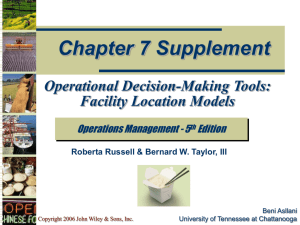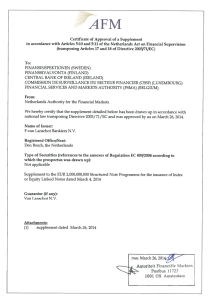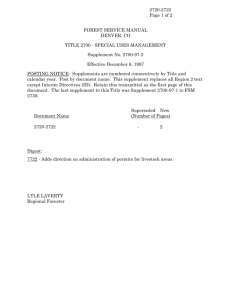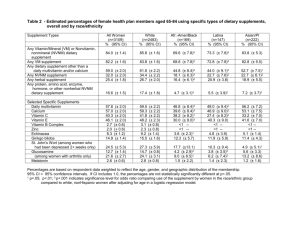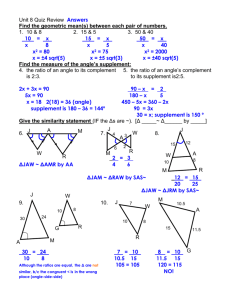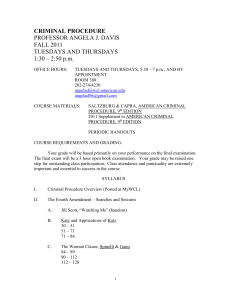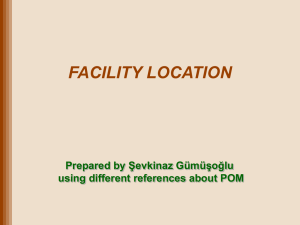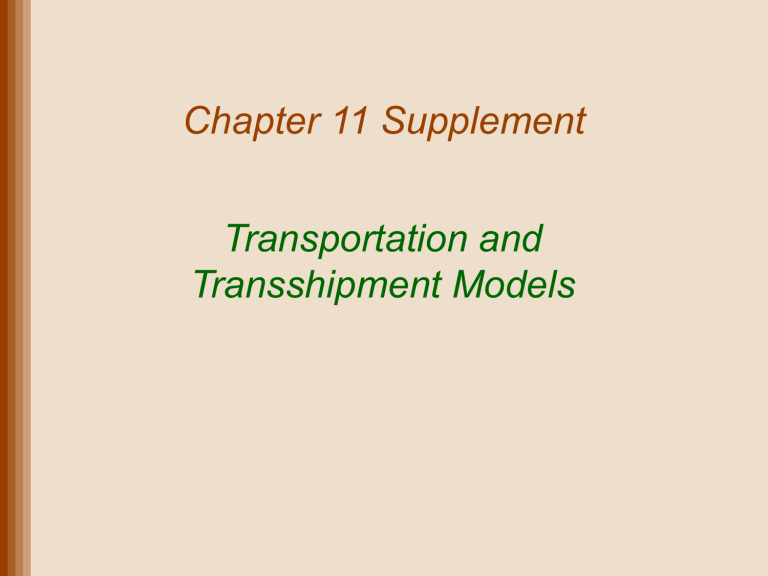
Chapter 11 Supplement
Transportation and
Transshipment Models
Just how do you make decisions?
•
•
•
•
•
Emotional direction
Intuition
Analytic thinking
Are you an intuit, an analytic, what???
How many of you use models to make
decisions??
Supplement 10-2
Problems
• Arise whenever there is a perceived difference
between what is desired and what is in
actuality.
• Problems serve as motivators for doing
something
• Problems lead to decisions
42
How many of you have used a model
before?
• Any kind of model??
Copyright 2011 John Wiley & Sons, Inc.
Supplement 11-4
Supplement 10-5
Model Classification Criteria
• Purpose
• Perspective
• Use the perspective of the targeted decision-maker
•
•
•
•
Degree of Abstraction
Content and Form
Decision Environment
{This is what you should start any modeling
facilitation meeting with}
Supplement 10-6
Purpose
•
•
•
•
Planning
Forecasting
Training
Behavioral research
Supplement 10-7
Perspective
• Descriptive
• “Telling it like it is”
• Most simulation models are of this type
• Prescriptive
• “Telling it like it should be”
• Most optimization models are of this type
Supplement 10-8
Degree of Abstraction
• Isomorphic
• One-to-one
• Homomorphic
• One-to-many
Supplement 10-9
Content and Form
•
•
•
•
•
verbal descriptions
mathematical constructs
simulations
mental models
physical prototypes
Supplement 10-10
Decision Environment
• Decision Making Under Certainty
• TOOL: all of mathematical programming—supplements
to Chapters 11 and 14
• Decision Making under Risk and Uncertainty
• TOOL: Decision analysis--tables, trees, Bayesian
revision—supplement to Chapter 1
• Decision Making Under Change and Complexity
• TOOL: Structural models, simulation models—
supplement to Chapter 13
Supplement 10-11
We will cover parts of….
•
•
•
•
The supplements to Chapters 11, 14 and 13
In that order
Network programming—suppl to Chap 11 today
Linear programming—suppl to Chap 14
tomorrow
• Simulation—suppl to Chap 13 Friday
• And test you on this on July 30
Copyright 2011 John Wiley & Sons, Inc.
Supplement 11-12
Mathematical Programming
• Linear programming
• Integer linear programming
• some or all of the variables are integer variables
• Network programming (produces all integer
solutions)
•
•
•
•
Nonlinear programming
Dynamic programming
Goal programming
The list goes on and on
• Geometric Programming
Supplement 10-13
Network Programming
•
•
•
•
•
•
•
Transportation model
Transhipment model
Shortest Route model (not covered)
Minimal Spanning Tree (not covered)
Maximal Flow model (not covered)
Assignment model (not covered)
Many other models
Copyright 2011 John Wiley & Sons, Inc.
Supplement 11-14
A Model of this class
• What would we include in it?
Supplement 10-15
Management Science Models: A Definition
• A QUANTITATIVE REPRESENTATION OF A
PROCESS THAT CONSISTS OF THOSE
COMPONENTS THAT ARE SIGNIFICANT FOR
THE ________ BEING CONSIDERED
Supplement 10-16
Mathematical programming models covered
in Ch 11, Supplement
• Transportation Model
• Transshipment Model
Not included are:
Shortest Route
Minimal Spanning Tree
Maximal flow
Assignment problem
many others
Supplement 10-17
Transportation Model
• A model formulated for a class of problems
with the following characteristics
• items are transported from a number of sources to
a number of destinations at minimum cost
• each source supplies a fixed number of units
• each destination has a fixed demand for units
• Solution Methods
• stepping-stone (by hand—a heuristic algorithm)
• modified distribution
• Excel’s Solver (uses Dantzig’s Simplex
optimization algorithm)
Copyright 2011 John Wiley & Sons, Inc.
Supplement 11-18
Transportation Method Example
Copyright 2011 John Wiley & Sons, Inc.
Supplement 11-19
Transportation Method
Copyright 2011 John Wiley & Sons, Inc.
Supplement 11-20
Problem Formulation with Excel
1. Click on “Data”
2. Solver
=C5+D5+E5
=E5+E6+E7
Total cost formula for all
potato shipments in cell C10
Copyright 2011 John Wiley & Sons, Inc.
Supplement 11-21
Solver Parameters
Total cost
Click to “solve”
Decision variables
representing
shipment routes
Constraints specifying
that supply at the
distribution centers
equals demand
at the plants
Click on “Options”
to activate “Assume
Linear Models”
Copyright 2011 John Wiley & Sons, Inc.
Supplement 11-22
Solution
Copyright 2011 John Wiley & Sons, Inc.
Supplement 11-23
The Underlying Network
Supplement 10-24
Copyright 2006 John Wiley & Sons, Inc.
Modified Problem Solution
High cost prohibits
route C5
Copyright 2011 John Wiley & Sons, Inc.
Column “H” added
for excess supply
Supplement 11-25
Modified Problem Settings
Constraint changed
to ≤ to reflect
supply > demand
Copyright 2011 John Wiley & Sons, Inc.
Supplement 11-26
OM Tools
Copyright 2011 John Wiley & Sons, Inc.
Supplement 11-27
Transshipment Model
Copyright 2011 John Wiley & Sons, Inc.
Supplement 11-28
Transshipment Model Solution
=SUM(B6:B7)
=SUM(B6:D6)
=SUM(C13:E13)
=SUM(C13:C15)
=C8-F14
Copyright 2011 John Wiley & Sons, Inc.
= B8-F13, the amount shipped
into KC equals the amount
shipped out
Supplement 11-29
Transshipment Settings
Transshipment constraints
Copyright 2011 John Wiley & Sons, Inc.
Supplement 11-30
For problems in which there is an
underlying network:
• There are easy (fast) solutions
• An exception is the traveling salesman problem
• The solutions are always integer ones
• {How about solving a 50,000 node problem in
less than a minute on a laptop??}
Supplement 10-31
CARLTON PHARMACEUTICALS
• Carlton Pharmaceuticals supplies drugs and other
medical supplies.
• It has three plants in: Cleveland, Detroit,
Greensboro.
• It has four distribution centers in:
Boston, Richmond, Atlanta, St. Louis.
• Management at Carlton would like to ship cases
of a certain vaccine as economically as possible.
Supplement 10-32
• Data
• Unit shipping cost, supply, and demand
From
From
Cleveland
Cleveland
Detroit
Detroit
Greensboro
Greensboro
Demand
Demand
Boston
Boston
$35
$35
37
37
40
40
1100
1100
• Assumptions
Richmond
Richmond
30
30
40
40
15
15
400
400
To
To
Atlanta
Atlanta
40
40
42
42
20
20
750
750
St.
St.Louis
Louis
32
32
25
25
28
28
750
750
Supply
Supply
1200
1200
1000
1000
800
800
• Unit shipping cost is constant.
• All the shipping occurs simultaneously.
• The only transportation considered is between sources
and destinations.
• Total supply equals total demand.
Supplement 10-33
Sources
NETWORK
REPRESENTATION
Destinations
D1=1100
Boston
Cleveland
Richmond
S1=1200
D2=400
Detroit
S2=1000
Atlanta
D3=750
Greensboro
S3= 800
Supplement 10-34
St.Louis
D4=750
• The Associated Linear Programming Model
• The structure of the model is:
Minimize <Total Shipping Cost>
ST
[Amount shipped from a source] = [Supply at that source]
[Amount received at a destination] = [Demand at that
destination]
• Decision variables
Xij = amount shipped from source i to destination j.
where: i=1 (Cleveland), 2 (Detroit), 3 (Greensboro)
j=1 (Boston), 2 (Richmond), 3 (Atlanta),
4(St.Louis)
Supplement 10-35
Supply from Cleveland X11+X12+X13+X14 = 1200
Supply from Detroit X21+X22+X23+X24
= 1000
Supply from Greensboro X31+X32+X33+X34 = 800
The supply constraints
Boston
D1=1100
X11
Cleveland
S1=1200
X12
X13
X21
X31
Richmond
X14
X22
Detroit
D2=400
X32
X23
S2=1000
X24
Atlanta
X33
St.Louis
Greensboro
S3= 800
X34
Supplement 10-36
D3=750
D4=750
• The complete mathematical programming
model
Minimize 35X11+30X12+40X13+ 32X14 +37X21+40X22+42X23+25X24+
40X31+15X32+20X33+38X34
ST
Supply constrraints:
X11+ X12+ X13+ X14
X21+ X22+ X23+ X24
X31+ X32+ X33+ X34
Demand constraints:
X11+
X12+
X13+
X21+
X31
X22+
X32
X23+
X14+
All Xij are
Supplement 10-37
X33
X24+
nonnegative
X34
= 1200
= 1000
= 800
= 1000
= 400
= 750
= 750
Excel Optimal Solution
CARLTON PHARMACEUTICALS
UNIT COSTS
BOSTON RICHMOND ATLANTA ST.LOUIS
CLEVELAND
$
35.00 $
30.00 $
40.00 $
32.00
DETROIT
$
37.00 $
40.00 $
42.00 $
25.00
GREENSBORO $
40.00 $
15.00 $
20.00 $
28.00
DEMANDS
1100
400
750
750
SHIPMENTS (CASES)
BOSTON RICHMOND ATLANTA ST.LOUIS
CLEVELAND
850
350
0
0
DETROIT
250
0
0
750
GREENSBORO
0
50
750
0
TOTAL
1100
400
SUPPLIES
1200
1000
800
750
TOTAL
1200
1000
800
750
TOTAL COST =
Supplement 10-38
84000
WINQSB Sensitivity Analysis
If this path is used, the total cost
will increase by $5 per unit
shipped along it
Supplement 10-39
Shadow prices for warehouses - the cost resulting from 1 extra case of vaccine
demanded at the warehouse
Shadow prices for plants - the savings incurred for each extra case of vaccine available at
the plant
Supplement 10-40
Transshipment
Model
Supplement 10-41
Transshipment Model: Solution
Supplement 10-42
DEPOT MAX
A General Network Problem
• Depot Max has six stores.
• Stores 5 and 6 are running low on the model
65A Arcadia workstation, and need a total of 25
additional units.
• Stores 1 and 2 are ordered to ship a total of 25
units to stores 5 and 6.
• Stores 3 and 4 are transshipment nodes with no
demand or supply of their own.
Supplement 10-43
• Other restrictions
• There is a maximum limit for quantities shipped on
various routes.
• There are different unit transportation costs for
different routes.
• Depot Max wishes to transport the available
workstations at minimum total cost.
Supplement 10-44
• DATA:
20
10
1
7
3
5
Arcs: Upper bound and lower bound constraints:
6
5
12
0 X ij U ij
2
15
4
11
7
15
–Supply nodes:
Network
presentation
6
Net flow out
of the node] nodes:
= [Supply at the node]
–Intermediate
transshipment
Transportation
X12
X15node]
- X21= =[Total
10 flow into the
(Node
1)
[Total
flow+ X13
out of+ the
node]
–Demand
nodes:
unit cost
X21
- X12
= 15
(Node
[Net flow
into +the
node]
= [Demand
for the node]
X34+X35
=X24
X13
(Node
3) 2)
X15 +X46
X35= +X65
X56 = 12
(Node 5)
X24 +- X34
(Node 4)
Supplement 10-45
X46
- X65
13
(Node 6)
Copyright
2006+X56
John Wiley
& Sons,=Inc.
• The Complete mathematical model
Minimize 5X12 10X13 20X15 6X21 15X24 12X34 7X35 15X46 11X56 7X65
ST
X12 + X13 + X15 - X21
- X12
= 10
+ X21 + X24
- X13
= 15
+ X34 + X35
- X24
- X15
- X34
= 0
+ X46
- X35
= 0
+ X56 - X65 = -12
- X46
- X56 + X65 = -13
0 X12 3; 0 X13 12; 0 X15 6; 0 X21 7; 0 X24 10; 0 X34 8; 0 X35 8;
0 X46 17; 0 X56 7; 0 X65 5
Supplement 10-46
WINQSB Input Data
Supplement 10-47
Copyright 2006 John Wiley & Sons, Inc.
WINQSB Optimal Solution
Supplement 10-48
Copyright 2006 John Wiley & Sons, Inc.
MONTPELIER SKI COMPANY
Using a Transportation model for production
scheduling
• Montpelier is planning its production of skis for the months
of
July, August, and September.
• Production capacity and unit production cost will change
from
month to month.
• The company can use both regular time and overtime to
produce skis.
• Production levels should meet both demand forecasts and
end-of-quarter inventory requirement.
• Management would like to schedule production to minimize
its costs for the quarter.
Supplement 10-49
• Data:
• Initial inventory = 200 pairs
• Ending inventory required =1200 pairs
• Production capacity for the next quarter = 400 pairs in
regular time.
= 200 pairs in
overtime.
• Holding cost rate is 3% per month per ski.
• ProductionForecasted
capacity, and
forecasted
demand
for this
Production
Production
Costs
Forecasted
Production
Production Costs
quarter
Month
Demand
Capacity
Month
Demand
Capacity Regular
RegularTime
Time Overtime
Overtime
July
400
1000
25
30
(in
cost
Julypairs of skis),
400 and production
1000
25 per unit
30 (by
August
600
800
26
32
August
600
800
26
32
months)
September
1000
400
29
37
September
Supplement 10-50
1000
400
29
37
• Analysis of demand:
• Net demand to satisfy in July = 400 - 200 = 200 pairs
•
Initial inventory
of Unit
costs= 600
•Analysis
Net demand
in August
Unitdemand
cost = [Unit
production =cost]
+ + 1200 = 2200 pairs
• Net
in September
1000
[Unit holding cost per month][the number of months stays in
Forecasted demand In house inventory
inventory]of Supplies:
• Analysis
•Example:
Production
capacities
thought
of as supplies.
A unit
producedare
in July
in Regular
time and sold in
•September
There arecosts
two sets
“supplies”:
25+ of
(3%)(25)(2
months) = $26.50
• Set 1- Regular time supply (production capacity)
• Set 2 - Overtime supply
Supplement 10-51
Network representation
Production
Month/period
1000
800
July
O/T
Aug.
R/T
25
25.75
26.50
0
30
30.90
31.80 +M
0
26
26.78
400
Aug.
O/T
Month
sold
July
+M
+M
32.96
200
Sept.
R/T
Sept.
O/T
Supplement 10-52
0
0
Aug.
600
Sept.
2200
Dummy
300
+M
0
29
400
+M
+M
32
200
Demand
Production Capacity
500
July
July
R/T
R/T
37
0
Source: July production in R/T
Source: Aug. production in O/T
Destination: July‘s demand.
Destination: Sept.’s demand
Unit cost= $25 (production)
32+(.03)(32)=$32.96
Unit cost =Production+one month holding cost
Supplement 10-53
Copyright 2006 John Wiley & Sons, Inc.
Supplement 10-54
Copyright 2006 John Wiley & Sons, Inc.
• Summary of the optimal solution
• In July produce at capacity (1000 pairs in R/T, and 500
pairs in O/T). Store 1500-200 = 1300 at the end of July.
• In August, produce 800 pairs in R/T, and 300 in O/T.
Store additional 800 + 300 - 600 = 500 pairs.
• In September, produce 400 pairs (clearly in R/T). With
1000 pairs
retail demand, there will be
(1300 + 500) + 400 - 1000 = 1200 pairs available for
shipment to
Ski Chalet.
Inventory +
Production Supplement 10-55
Demand
Problem 4-25
Supplement 10-56
Copyright 2006 John Wiley & Sons, Inc.
Supplement 10-57
Copyright 2006 John Wiley & Sons, Inc.
Supplement 10-58
Copyright 2006 John Wiley & Sons, Inc.
Supplement 10-59
Copyright 2006 John Wiley & Sons, Inc.
Supplement 10-60
Copyright 2006 John Wiley & Sons, Inc.
6.3 The Assignment Problem
• Problem definition
• m workers are to be assigned to m jobs
• A unit cost (or profit) Cij is associated with worker i
performing job j.
• Minimize the total cost (or maximize the total
profit) of assigning workers to job so that each
worker is assigned a job, and each job is
performed.
Supplement 10-61
BALLSTON ELECTRONICS
• Five different electrical devices produced on five
production lines, are needed to be inspected.
• The travel time of finished goods to inspection
areas depends on both the production line and the
inspection area.
• Management wishes to designate a separate
inspection area to inspect the products such that
the total travel time is minimized.
Supplement 10-62
• Data: Travel time in minutes from assembly
lines to inspection areas.
Assembly
Assembly
Lines
Lines
11
22
33
44
55
Supplement 10-63
AA
10
10
11
11
13
13
14
14
19
19
BB
44
77
88
16
16
17
17
Inspection
Inspection Area
Area
CC
66
77
12
12
13
13
11
11
DD
10
10
99
14
14
17
17
20
20
EE
12
12
14
14
15
15
17
17
19
19
NETWORK REPRESENTATION
Assembly Line
S1=1
1
Inspection Areas
A D1=1
S2=1
2
B
S3=1
3
C D3=1
S4=1
4
D
D4=1
S5=1
5
E
D5=1
Supplement 10-64
D2=1
• Assumptions and restrictions
• The number of workers equals the number of jobs.
• Given a balanced problem, each worker is assigned
exactly once, and each job is performed by exactly one
worker.
• For an unbalanced problem “dummy” workers (in case
there are more jobs than workers), or “dummy” jobs (in
case there are more workers than jobs) are added to
balance the problem.
Supplement 10-65
• Computer solutions
• A complete enumeration is not efficient even for
moderately large problems (with m=8, m! > 40,000
is the number of assignments to enumerate).
• The Hungarian method provides an efficient
solution procedure.
• Special cases
• A worker is unable to perform a particular job.
• A worker can be assigned to more than one job.
• A maximization assignment problem.
Supplement 10-66
6.5 The Shortest Path Problem
• For a given network find the path of minimum
distance, time, or cost from a starting point,
the start node, to a destination, the terminal
node.
• Problem definition
• There are n nodes, beginning with start node 1 and
ending with terminal node n.
• Bi-directional arcs connect connected nodes i and j
with nonnegative distances, d i j.
• Find the path of minimum total distance that connects
node 1 to node n.
Supplement 10-67
Fairway Van Lines
Determine the shortest route from Seattle to El Paso
over the following network highways.
Supplement 10-68
Seattle
1
497
180
3
432
Portland
Sac.
Reno
6
691
420
345
Bakersfield
114
13
Los Angeles
440
7
526
11
621
Denver 9
Las Vegas
108
155
Barstow
14
469
15
Albuque.
Phoenix
425
12
403
16
118
San Diego
Supplement 10-69
452
Kingman
207
386
17
8
102
432
280
Cheyenne
Salt Lake City
291
10
Butte
2
Boise
4
138
5
599
Tucson
18
314
19
El Paso
• Solution - a linear programming approach
Decision variables
1 if a truck travels on the highway from city i to city j
X ij
0 otherwise
Objective = Minimize S dijXij
Supplement 10-70
Subject to the following constraints:
1
Seattle
180
497
3
432
Portland
Butte
599
2
Boise
4
345
Salt Lake City
7
[The number of highways traveled out of Seattle (the start node)] = 1
X12 + X13 + X14 = 1
In a similar manner:
[The number of highways traveled into El Paso (terminal node)] = 1
X12,19 + X16,19 + X18,19 = 1
Supplement 10-71
Nonnegativity
constraints
[The number of highways used to travel into a city] =
[The number of highways traveled leaving the city].
For example, in Boise (City 4):
X14 + X34 +X74 = X41 + X43 + X47.
WINQSB Optimal Solution
Supplement 10-72
Copyright 2006 John Wiley & Sons, Inc.
• Solution - a network approach
The Dijkstra’s algorithm:
• Find the shortest distance from the “START” node to every
other node in the network, in the order of the closet nodes to
the “START”.
• Once the shortest route to the m closest node is determined,
the shortest route to the (m+1) closest node can be easily
determined.
• This algorithm finds the shortest route from the start to all the
nodes in the network.
Supplement 10-73
An illustration of the Dijkstra’s algorithm
+ 420
SLC.=
SLC
599
BUT.
BUT
691
+
CHY.
=
345 =
+ SLC
SLC.
SLC
497
SEA.
BOI
BOI
BOI.
Seattle
1
497
180
3
599
2
691
Boise
420
432
Portland
138
4
Reno
345
POR.
POR
180
180
Sac.
Salt Lake City
6
102
621
291
10
Bakersfield
Denver 9
… and so on
until the
Kingman
Barstow
whole network
15
12
14
Albuque.
isPheonix
covered.
11
280
Las Vegas
108
452
155
469
207
Supplement 10-74
8
432
114
+ 602 =
SACSAC.
Cheyene
440
7
526
5
+ 432 =
BOIBOI
Butte
13
Los Angeles
386
San Diego
403
16
118
17
425
Tucson
18
19
314
El Paso
6.6 The Minimal Spanning Tree
• This problem arises when all the nodes of a
given network must be connected to one
another, without any loop.
• The minimal spanning tree approach is
appropriate for problems for which redundancy
is expensive, or the flow along the arcs is
considered instantaneous.
Supplement 10-75
THE METROPOLITAN TRANSIT DISTRICT
• The City of Vancouver is planning the development of a
new light rail transportation system.
• The system should link 8 residential and commercial
centers.
• The Metropolitan transit district needs to select the set
of lines that will connect all the centers at a minimum
total cost.
• The network describes:
• feasible lines that have been drafted,
• minimum possible cost for taxpayers per line.
Supplement 10-76
SPANNING TREE
NETWORK
North Side
PRESENTATION
3
34
University
50
5
Business
District
39
4
West Side
45
1
8
35
2
City
Center
41
7
Supplement 10-77
6
South Side
Shopping
Center
East Side
• Solution - a network approach
• The algorithm that solves this problem is a very easy
(“trivial”) procedure.
• It belongs to a class of “greedy” algorithms.
• The algorithm:
• Start by selecting the arc with the smallest arc
length.
• At each iteration, add the next smallest arc length to
the set
of arcs already selected (provided no loop is
constructed).
• Finish when all nodes are connected.
• Computer solution
• Input consists of the number of nodes, the arc length,
and the network description.
Supplement 10-78
WINQSB Optimal Solution
Supplement 10-79
Copyright 2006 John Wiley & Sons, Inc.
OPTIMAL SOLUTION
NETWORK
REPRESENTATION
3
North Side
34
West Side
University
50
5
Business
District
39
4
45
Loop
1
8
35
2
City
Center
41
6
Total Cost = $236 million
7
Supplement 10-80
South Side
Shopping
Center
East Side
Copyright 2011 John Wiley & Sons, Inc.
All rights reserved. Reproduction or translation of this
work beyond that permitted in section 117 of the 1976
United States Copyright Act without express permission
of the copyright owner is unlawful. Request for further
information should be addressed to the Permission
Department, John Wiley & Sons, Inc. The purchaser
may make back-up copies for his/her own use only and
not for distribution or resale. The Publisher assumes no
responsibility for errors, omissions, or damages caused
by the use of these programs or from the use of the
information herein.
Copyright 2011 John Wiley & Sons, Inc.
Supplement 11-81

